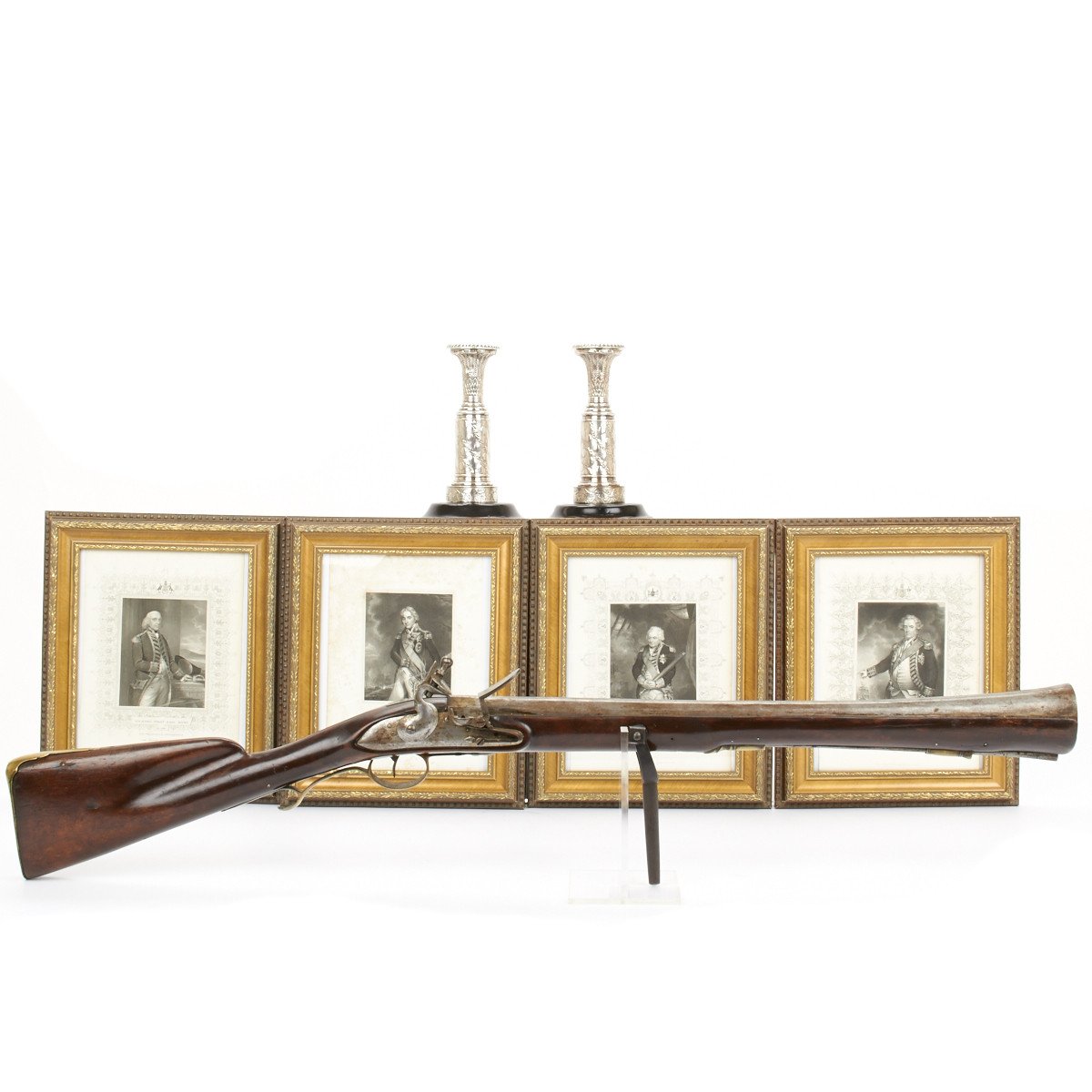Original 1798 Battle of the Nile Set- French Blunderbuss, British Naval Candlesticks and Prints Original Items
$ 11.995,00 $ 2.998,75
Original One-of-a-Kind Set. This fine French blunderbuss is one of the very few Non-British items that ws acquired from the Strakaty Collection of Vienna, Austria. A French light swivel flintlock blunderbuss as used on a long boat or on a ship’s rail. Notable features include-a plain lock, very swamped iron barrel measuring 23-inches overall and 2.25-inches across the muzzle, full brass mounts and still retains the original swivel mounting.
What however makes this blunderbuss so interesting is the brass butt plate that bears
an engraved inscription reading:
A PRIZE , Recovered from L’Orient at ABOURKIR BAY after the action, 1st August 1798
Clearly a memento of one of Nelson’s most famous battles most probably recovered from a long boat as history tells us the French flagship L’Orient blew up with catastrophic results and a major loss of life. Abourkir Bay, better known as the Battle of the Nile was really the moment
Nelson landed in historys pages. His exploits are legend but were so short lived with his death, at the hands of a French Marksman, about H.M.S. Victory at the Battle of Trafalgar in 1805.
Together with this memento of The Battle of The Nile is a pair of wonderful silver beaten over copper, known as Sheffield plate, ships candlesticks (circa 1799) made to commemorate the recent great British Naval victories of the day. Specifically naming the commanders of the actions and the dates as follows:
HOWE, 1st June 1794 (The Battle of the Glorious 1st of June)
JERVIS, 14th February 1797 (The Battle of Cape St.Vincent)
DUNCAN, 11th October 1797 (The Battle of Camperdown)
NELSON, 1st August 1798 (The Battle of Abourkir Bay)
These candlesticks were made obviously after news of the Nile Victory arrived in England but before Nelson’s next great triumph at The Battle of Copenhagen on 2nd April 1801, placing the date of manufacture between 1798 and 1801.
A magnificent and extremely rare pair of candlesticks that have conspicuous wide wood bases which were an essential requirement when used aboard ship. Each is beautifully embossed with fouled anchors and other military devises.
Also included with these wonderful candlesticks are framed period prints of each of the named Naval Commanders at the four Battles commemorated, a fitting tribute to these British Heroes of the day.
The blunderbuss came from the Strakaty collection and was obtained by IMA in the 1980s, the magnificent candlesticks made between 1798 and 1801, were recently acquired from a leading Maritime collection in Cape Cod, Massachusetts.
Fast Shipping with Professional Packaging
Thanks to our longstanding association with UPS FedEx DHL, and other major international carriers, we are able to provide a range of shipping options. Our warehouse staff is expertly trained and will wrap your products according to our exact and precise specifications. Prior to shipping, your goods will be thoroughly examined and securely secured. We ship to thousands clients each day across multiple countries. This shows how we're dedicated to be the largest retailer on the internet. Warehouses and distribution centres can be located throughout Europe as well as the USA.
Note: Orders with more than one item will be assigned a processing date depending on the item.
Before shipping before shipping, we'll conduct a thorough inspection of the items you have ordered. Today, the majority of orders will be delivered within 48 hours. The delivery time will be between 3-7 days.
Returns
The stock is dynamic and we cannot completely manage it because multiple stakeholders are involved, including our factory and warehouse. So the actual stock may alter at any time. It's possible that you may not receive your order once the order has been made.
Our policy is valid for a period of 30 days. If you don't receive the product within 30 days, we are not able to issue a refund or an exchange.
You can only return an item if it is unused and in the same state as the day you received it. You must have the item in its original packaging.
Related products
Uncategorized
Uncategorized
Angolan Rebel 1970s era 60mm Inert Display Mortar from Angolan Civil War Original Items
Uncategorized
Uncategorized
Uncategorized
Uncategorized
Uncategorized
Australian WWII Owen MK1 Machine Carbine SMG Custom Fabricated Replica with Sling Original Items
Uncategorized
Uncategorized
Uncategorized
Armored Burgonet Helmet & Polearm from Scottish Castle Leith Hall Circa 1700 Original Items
Uncategorized
Uncategorized
Uncategorized
Uncategorized
Uncategorized
Uncategorized
Armoured Fighting Vehicles of the World: AFVs of World War One (Hardcover Book) New Made Items
Uncategorized
Uncategorized
Uncategorized












































































